Brief

Autonomous vehicles, with their promising pilot programs and enormous potential, make headlines in business and technology news every day. Self-driving cars and trucks promise to dramatically change the economics of nearly every industry, and it seems likely that eventually many people will no longer feel the need to own a car or even know how to drive.
However, the path to this driverless future is more complex than a first glance might suggest. Fully autonomous cars are likely to remain a small-volume market for some time. In the interim, assistive technologies will play a much larger role in the industry, as drivers come to rely on technology that guides them and supports their driving decisions. Mastering these new technologies will be essential for automakers and suppliers, and doing so will help build the capabilities they will need to deliver reliable, autonomous cars. The implications for top-tier suppliers are that they will need to play in two closely related but distinct segments:
• Advanced driver assistance systems (ADAS). For at least the next decade, most consumers are more likely to buy vehicles that use technology only to assist drivers—things like automated emergency braking or assistive parking—rather than fully autonomous cars (see Figure 1). The deployment of assistive technologies such as radar and computer vision will depend on consumers’ willingness to pay for features based on these technologies, and most are not willing to pay much more than they do now. But costs will drop as volumes scale. Increasingly, automakers will be required to include advanced safety features if they want to keep their top safety ratings. Other features, such as advanced cruise control or lane-changing assistance, will rely on the same basic hardware and could be activated with software upgrades.
• Autonomous driving (AD). Fully autonomous vehicles are likely to remain elusively expensive for most car buyers over the next few years, provided they become accessible to private customers at all and regulations evolve to allow autonomous driving. But they will become increasingly attractive to taxi services and other shared mobility service providers who can justify their expense because it reduces their costs by replacing some drivers. While autonomous vehicles are currently possible, they require an extensive and expensive set of sensors and software along with exemptions from standard regulations. So far, their use is mostly limited to pilots within geo-fenced areas. Although the size of this opportunity will depend on a range of factors related to urban density and consumer acceptance of car sharing, the market for fully autonomous vehicles is likely to remain small over the next 5 to 10 years. Even so, the market for these vehicles will be an important development platform, as carmakers and suppliers climb the learning curve required to build and market fully autonomous vehicles.
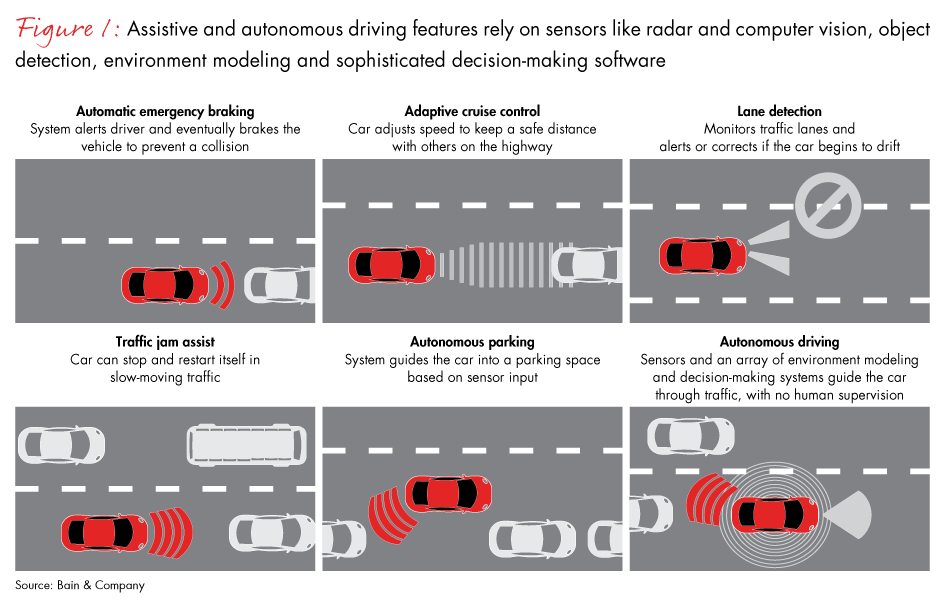
Top-tier suppliers with leadership ambitions will need to play in both segments. They will have to provide automakers with cost-effective ADAS solutions that integrate with the automaker’s larger systems. They will also need to invest in pilot programs that test autonomous driving technologies in limited range projects while monitoring the global market. And they will need to do much more: To become a leader in assistive and autonomous technology, each will need to develop new capabilities, especially in certain aspects of software engineering, such as raw data fusion and machine learning. They will also need to facilitate mergers and acquisitions (M&A) as well as strategic partnerships and alliances to ensure access to important technologies and skills. Above all, they will have to change the way they operate, becoming more agile and maintaining a flexible approach to strategy while strengthening their own technological culture.
ADAS drives economics, shared mobility drives innovation
The business-to-business (B2B) market for assistive and autonomous technologies, which includes software, hardware and services sold by suppliers to automakers, promises to be attractive, even in pessimistic scenarios. Bain estimates that the global opportunity will be in the range of $22 to $26 billion annually by 2025, with yearly growth between 12% and 14% (see Figure 2). Our estimates, based on more than 50 interviews with industry experts and executives from suppliers as well as from 12 leading automakers, assumes significant price declines in both conservative and optimistic scenarios as new technologies achieve scale production. In all scenarios the majority of both the volume and value in the market will remain in driver assistance systems, which require a human driver to continue monitoring the vehicle. Even in our most optimistic scenario, by 2025 only 10% of ADAS/AD systems will be partly or fully automated, replacing the driver or at least allowing drivers to divert their attention from the driving task under specific circumstances (conditional automation).
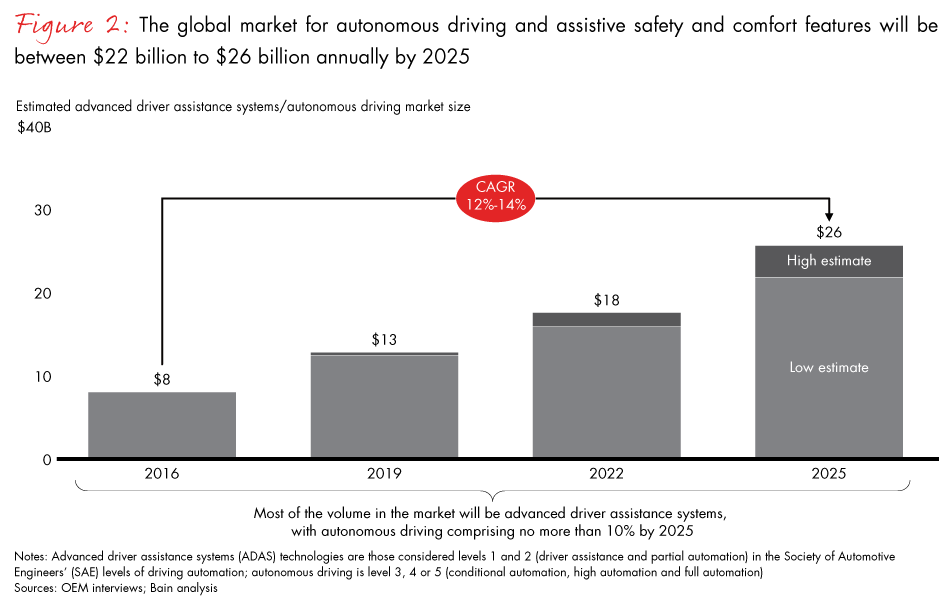
The number of autonomous vehicles is likely to remain small for the next 5 to 10 years, even in the most receptive markets. How small? As a thought experiment, consider Germany. About 56,000 taxicabs operate in that country and they get replaced about every three years. Even if all of those new taxis were autonomous cars, and even if the better economics of robo-cabs led to an increase of perhaps eight or nine times as many taxis, annual registrations of new robo-cabs would still account for only 5% of all new cars sold there.
Growth is unlikely to be slow and steady across markets. Rather, we are likely to see hotspots of growth, spurred by regulations and incentives, particularly in dense urban areas. Some cities, including Shanghai, London, Stockholm and Singapore, are already beginning to limit easy access to their densely populated centers, through tolls or other measures. Regulations like these are likely to make car ownership prohibitively expensive in some big cities. When combined with favorable economics for taxi use, these areas could see large autonomous fleets, and any carmaker or supplier that does not have a competitive AD offering will find itself locked out of these markets. Since it is difficult to predict when and where these hotspots will emerge, top-tier suppliers should be investing now in their autonomous driving capabilities.

The Future of Autonomous Driving
A look at how automakers and suppliers can win in the autonomous driving market.
Two critical areas that suppliers will need to invest in are raw data fusion and machine learning, both of which are necessary to enable AD vehicles systems to reliably analyze data from multiple sensors and make correct driving decisions in the absence of a human driver. For ADAS applications, even though raw data fusion would yield superior results, it is sufficient to compare the objects detected by each sensor. Such a system will not be available under all conditions, and sometimes mistakes will happen; for example, an object that the system has not been sufficiently trained for might not be properly detected. But since the driver is in control all the time and the system is only assisting, the driver will avert any dangerous situations by intervening. But for fully autonomous cars, the driving system must always be available and make the right decision every time. Therefore, systems for autonomous cars need to draw on as many data sources as possible and use the full depth of the data to create an accurate model of the environment. AD systems will combine the radar and camera data central to ADAS with input from additional sensors and sources—for example, light radar (LiDAR), high-definition maps and crowdsourced sparse data maps (see Figure 3). Combining raw data from different sources and using cutting-edge machine learning algorithms to recognize objects in the fused raw data allows the autonomous car to create a sufficiently good model of its environment in order to make correct decisions about what’s ahead on the road and how it should respond. Mastering this level of complexity will require alliances and partnerships for most players.
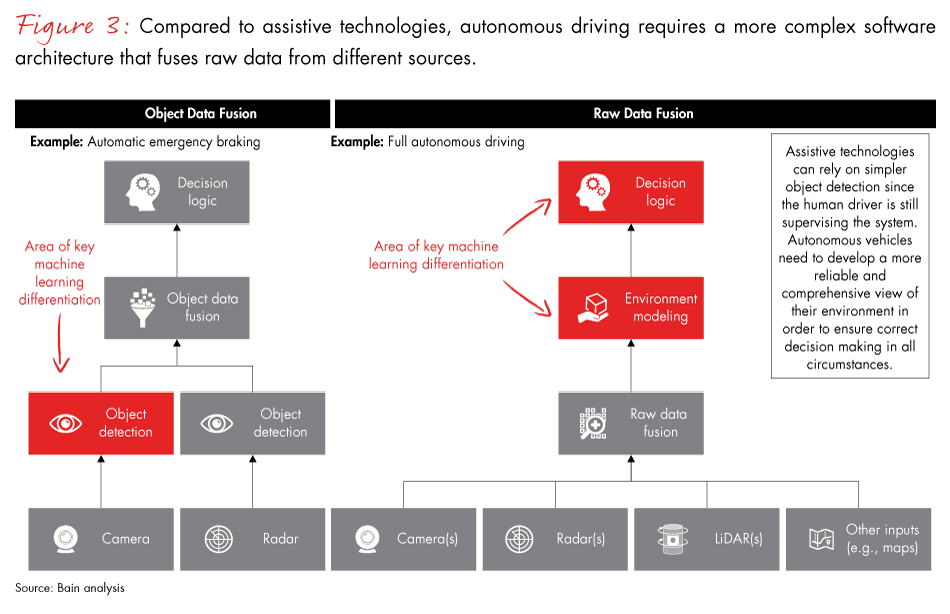
What do consumers want?
To get a better idea of what car buyers are willing to pay for, Bain surveyed more than 4,200 consumers in eight main automotive markets about the features they want most, from fully autonomous vehicles to simple ADAS technologies like parking assistance or rear-view cameras. About 80% of buyers said they were likely to use assistive features (see Figure 4). Only about half of buyers expressed interest in using vehicles that are fully autonomous today, even though two-thirds agreed that autonomous vehicles represented the future of driving.
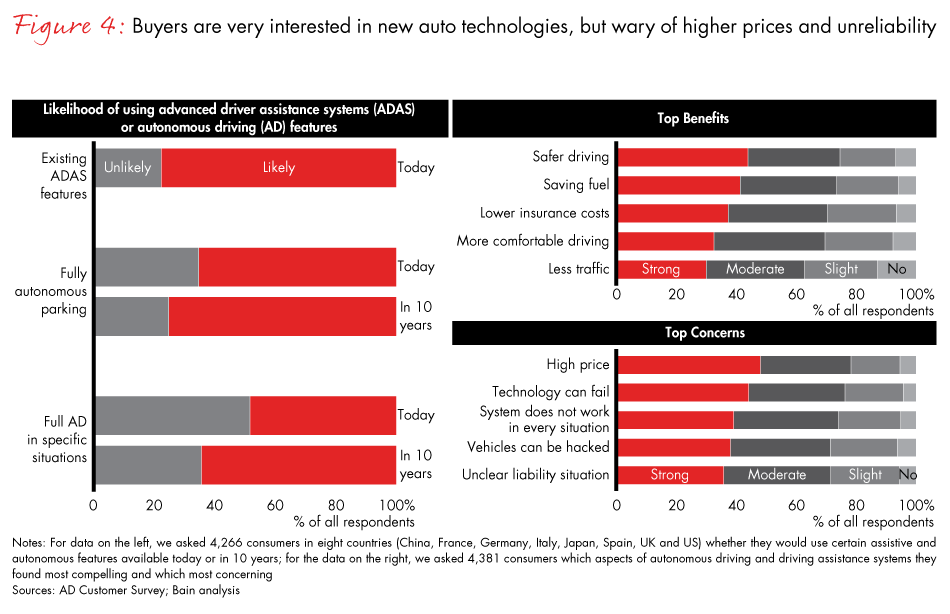
Drivers named safer driving and lower fuel and insurance costs as the leading benefits from these technologies. However, their enthusiasm is tempered by concerns about high costs and the reliability of the technology, including its vulnerability to being hacked. Liability issues were also a concern. Our research, which examined the trade-offs buyers were willing to make between different features of a car, showed that customers were not willing to spend much more on advanced ADAS features (including fully autonomous highway driving) than they spend today on basic ADAS features like adaptive cruise control (see Figure 5). Thus automakers and suppliers have their work cut out for them: Not only do they have to deliver the technology leaps to meet increasing customer expectation regarding both the capability and reliability of these systems, but they will also have to do so at costs that match those of today’s assistive features.
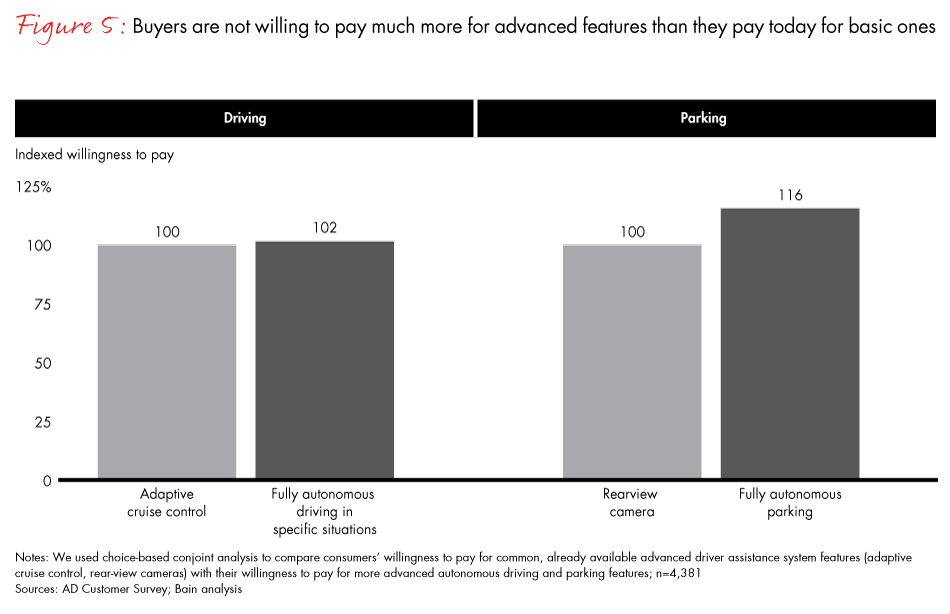
Two uncertainties shaping the market
As the technologies and markets evolve, automakers and suppliers will want to monitor a range of factors that will shape their direction and pace. Bain’s work with clients has identified nearly 70 factors that will affect the market and shape strategic decisions and development. Two uncertainties, in particular, are key to understanding the development of the advanced auto market.
-
Speed of adoption. Regulation and customer demand will work together to speed up or slow down the adoption of these technologies. Some countries have already relaxed rules to accommodate autonomous trials, but most still prohibit vehicles that are not under control of a human driver. As trials prove the technology’s viability, these regulations will evolve.
Customer demand will depend not just on willingness to pay but also on changing norms. Drivers often see new features in friends’ cars or try them out when they rent cars while traveling. Once accustomed to assistive features like rear camera views, electronic stability control or adaptive cruise control, drivers come to expect it. Acceptance of robo-cabs and other autonomous cars is likely to follow a similar trajectory, and many will encounter these when they visit an early adopter location. Positive experiences will contribute to the perception of safety, while any negative incidents are likely to reinforce concerns about reliability.
-
Entry of new players. Two distinct groups of new players are likely to shape the way the ADAS and autonomous markets unfold. One group comprises technology companies looking for new market opportunities and recognizing the synergies between their capabilities and those required for advanced autos. Apple, Google, Tesla and Uber are the most visible Silicon Valley players, but many other companies, including Intel and Nvidia, are entering the market at the supplier level with software and hardware components. These players have the potential to disrupt the market with innovative technical solutions and business models—for example, offering software at no cost to automakers in exchange for access to data, which they could then use for marketing or other purposes.
The second group of players includes companies that may receive support from their governments in the form of favorable financing, partnerships or regulations. In China, some state-owned enterprises could receive limited support, though the emphasis there is more on electric vehicles than autonomous driving. Some companies in South Korea are also likely candidates. Traditional top-tier suppliers will need to find ways to work constructively or compete with these national champions and their governments, forming partnerships or competitive alliances in those regions and beyond.
Top-tier suppliers will need to expand their strategic scans beyond their traditional competitors to include companies in these two groups in order to keep from being surprised or disintermediated.
New automotive technologies offer top-tier suppliers highly attractive opportunities across two segments: advanced driver assistance systems and autonomous driving. Hans Joachim Heider and Christoph Schlegel, partners with Bain's Technology practice, discuss how leading suppliers can play in both segments with a flexible strategy.
How leading suppliers will win
Since no one can say how the development of assistive and autonomous technologies for cars will unfold, leading suppliers will need to adopt a scenario-based approach to strategy, identifying different possible outcomes and defining the signposts that will help them track developments and make adjustments accordingly.
As these scenarios evolve, leading companies will seek to take and hold market share. To do that, they’ll need to take action on four fronts.
-
Play in both AD and ADAS segments. As noted, fully autonomous cars are likely to remain most interesting to mobility service providers over the next decade while individual consumers will remain comfortable with assistive features only—at least until autonomous vehicles are well proven and economical.
Leading automakers and top suppliers will have their eye on both markets. Suppliers should continue to develop and sell cost-effective assistive solutions as they strengthen their expertise, their commercial relationships and their brands as suppliers of assistive and autonomous technologies. System integration skills will become increasingly crucial as automakers seek to reduce their internal complexity and source complete systems rather than components. In addition, smaller carmakers will lack the scale to develop the software components required for advanced ADAS systems at a competitive price point in-house.
Meanwhile, leaders will look for ways to begin to play in the autonomous market. Even though autonomous taxis and other vehicles are not likely to reach significant scale for another decade, participation in pilot programs will be critical for developing expertise and earning a seat at the table where standards will be set.
-
Monitor the market for signs of strategic surprise and disruption. For top-tier suppliers, it will become increasingly important and valuable to scan the entire landscape in order to understand the competitive moves not only of other top suppliers but also of technology companies and second-tier suppliers looking to capture a larger part of the market. It will be especially important to understand the motivations and capabilities of new entrants and potential disruptors—not only the technology players, but also low-cost suppliers from China and South Korea—and their market penetration in order to be able to adjust their own strategies accordingly. A wave of software start-ups focusing on data fusion and the decision layer warrant special attention.
-
Develop key capabilities. Although top suppliers are well positioned to continue to lead into the era of autonomous vehicles, the most successful companies are likely to be those that develop new competencies essential for leadership as the industry evolves. Key among these are technological capabilities, including software engineering, especially in the areas of raw data fusion and machine learning. Suppliers will have to work hard to attract top talent, a challenge that will require improving the tech culture of most firms. Companies with strong tech cultures empower their employees, break traditional hierarchical structures and provide greater flexibility and room for creativity. This new way of working is often facilitated by communal spaces that encourage collaboration and informal encounters, as well as problem-solving hackathons or other social meetups. Taken as a whole, this kind of dynamic and flexible culture can be a competitive edge that enables companies to move fast and take risks when necessary to win new business.
-
Pursue mergers, acquisitions and partnerships. M&A will become increasingly important as ways to acquire talent and fill gaps in capabilities, in order to allow suppliers to deliver complete and fully functional systems. M&A and strategic partnerships will continue to be a critical tool to close technology gaps, particularly around the important control points of raw data fusion and machine learning.
In order to thrive in this increasingly competitive environment, top-tier suppliers will need to move from the reactive stance of a component maker to a more proactive position based on a unique perspective on the market and customer preferences. Accomplishing such a significant shift will require a fundamental reassessment of the operating model in order to compete in the more dynamic environment of ADAS and AD markets, which differ greatly from traditional top-tier supplier markets. This environment will also include new opportunities that take advantage of the connectivity of ADAS and AD cars and the data they record. All of this will make these vehicles part of the autonomous battleground of the Internet of Things. (For more on this subject, see the Bain Brief “Defining the Battlegrounds of the Internet of Things.”)
As automakers come to rely on suppliers to deliver complete integrated systems, the makers of those systems must develop their own understanding of customers, what they want and what they’re willing to pay for today and in the future. Suppliers that can deliver these solutions will make themselves indispensable to the automakers.
Implications for leading top-tier auto suppliers in the ADAS/AD market
- Play in both segments
- ADAS. Provide cost-effective, modular and scalable ADAS solutions and system integration services. Automakers are looking for off-the-shelf integration at costs that do not raise the price of vehicles. Aggressive cost management will be essential.
- Autonomous. Invest in advanced, geo-fenced AD solutions and pilot projects. Shared mobility will remain a small market by volume for a while, but participating in pilot projects, where standards and reputations are shaped, will be critical from a strategic perspective.
- Monitor the market for signs of strategic surprise and disruption
- Focus on new entrants—not just tech players but also low-cost suppliers from, for example, China and South Korea. Adjust strategy accordingly, depending on their product development and market penetration.
- A wave of software start-ups in data fusion and the decision layer also bear watching.
- Develop key capabilities
- Gain competency in software engineering, especially raw data fusion and machine learning, by hiring talent, creating partnerships or through M&A.
- Nurture a tech mindset. Empower your employees, move faster and take more risks, while still providing automotive grade quality.
- Adopt a flexible posture that allows the company to move quickly on new opportunities.
- Pursue mergers, acquisitions and partnerships
- Improve M&A and joint venture capabilities to obtain necessary skills, technologies and talent.
- Develop partnerships necessary to deliver complete solutions to automakers.
Hans Joachim Heider is a partner with Bain & Company in Munich. Michael Schallehn is a partner with Bain in Silicon Valley. Christoph Schlegel and Klaus Stricker are partners in Bain’s Frankfurt office. Hans Joachim leads Bain’s Technology practice in Europe, the Middle East and Africa, and Klaus leads Bain’s Global Automotive practice.
The authors wish to thank Eva-Maria Hempe, a manager in Bain’s Zurich office, for her contributions to this brief.




